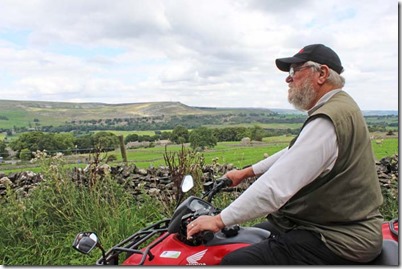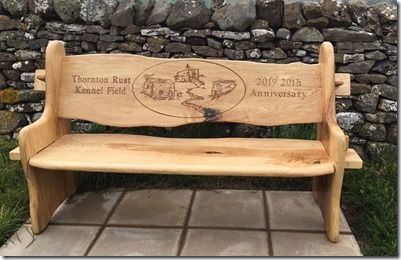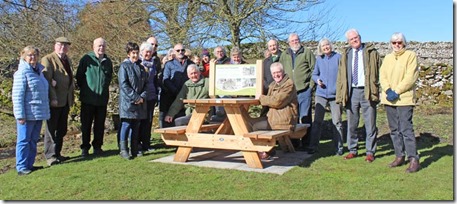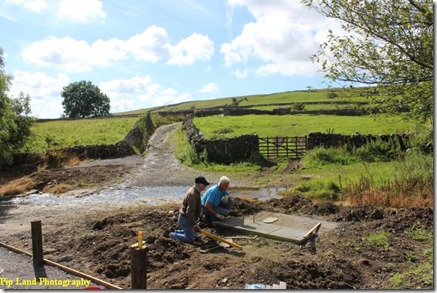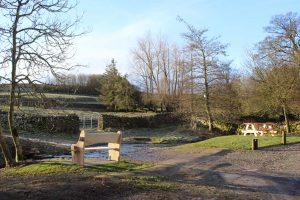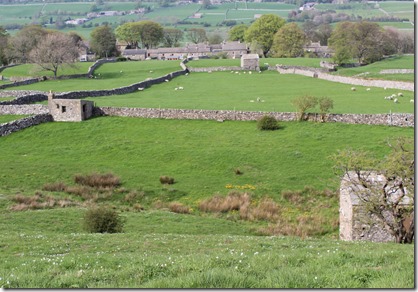Villagers at Thornton Rust raised their glasses to my husband, David Pointon, on Saturday June 1. He had died just two weeks before the 20th anniversary celebration of the founding of the village’s Kennel Field Trust. Above: David on his quad bike overlooking Wensleydale from near the Kennel Field.
At that celebration the villagers also raised their glasses to the continued prosperity of what is often known as the Millennium Field. The Kennel Field Trust was set up to bring that field, once used by the Wensleydale Harriers for kennelling its hounds, into public ownership and to restore it.
The Yorkshire Dales Millennium Trust (YDMT) had supported the Kennel Field Trust then – and, as part of its own 20th anniversary celebrations awarded a further grant of £4,000.
At the party in Thornton Rust village hall on Saturday the chairman of the Kennel Field Trust, John Dinsdale, explained that this grant was used to install new fencing, reinstate the cooking area of the mash house, order an interpretation board and install a new bench.
Deborah Millward, the Trust’s secretary, told those who had gathered in the village hall: “Dave [Pointon] had been associated with the Kennel Field for at least 15 years and for much of that time he was a trustee.
“I think what appealed to him and the rest of us was the ethos of the Kennel Field: that it was owned by the community; that the villagers could freely wander wherever they wanted there – enjoy the flowers, enjoy the birds, and enjoy the view.”
She added that he was a very good artist and had designed the artwork for the new bench. “Sadly he hasn’t been to see it but he did have photographs. I think he would be wanting us to celebrate and so I would like you to raise your glasses in joyful memory to Dave.”
His wife, Pip, said later: “As his mobility was becoming more and more restricted he had bought a quad bike so that he could still visit the Kennel Field and go up onto the moors. He loved the Yorkshire Dales and still wanted to enjoy them.”
Below: the new bench with David’s artwork engraved on it.
David was an Aysgarth and District parish councillor for Thornton Rust and a member of its village hall committee.
He was chairman of Northallerton branch of the Institute of Advanced Motorist and a Qualified Observer (trainer).
He was on the Representative Group for West Burton CofE School and then a member of the Bainbridge, Askrigg and West Burton Federation of Schools Working Party.
Before he retired to Wensleydale in 2001 he was head of service in Norfolk for children and young people with sensory impairment. He set up that service in 1983 and through it children were brought from boarding schools for the blind and visually impaired into main stream education. This led to him being a representative for teachers of the blind and visually impaired on the Special Educational Needs National Advisory Council and being a trustee of a charity aimed at helping such children in The Gambia.
After retirement he made several overland journeys to The Gambia to deliver equipment to the only school for the blind and visually impaired in that country and to run training classes for teachers working with them. David and I also introduced Heather Ritchie of Rug Aid to that school and it is wonderful to see how her work in The Gambia has developed since then.
He also served as a governor at Risedale School until it was converted into an academy and at Leeming Bar CofE Primary. He was involved for a time with Reeth School through the Quaker Trust as well as being a governor for six years at Breckenbrough School at Sandhutton run by North Yorkshire Quakers.
His funeral will be at Gorleston Crematorium as he died on his boat on the Norfolk Broads and as his daughter and some of his closest friends live in Norfolk.
Later there will be a Memorial Meeting at Bainbridge Quaker Meeting House. As one of those who worked with him in the Sensory Support service commented: “His discovery of the Quaker faith gave him an anchor later in life and I know he loved the life ‘up North’ surrounded by such magnificent countryside.”
Pip’s message on Facebook on May 21:
Sadly my wonderful husband, David, died suddenly on Sunday – [sitting] in his favourite place on his boat on the Norfolk Broads. I am so grateful to the strangers who helped me with CPR, to the paramedics and ambulance staff who worked so hard to bring him back, to Eddie my son for driving from London to be with me that evening and for being a tower of strength, and to the Bondi family, especially Jim and Sue for caring for me so well at their home.
